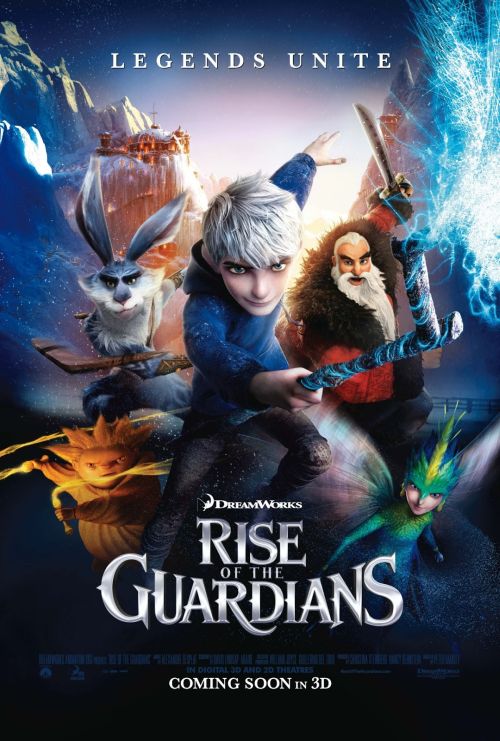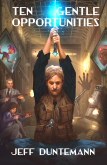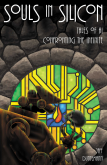
A few nights ago, Carol and I watched Dreamworks’ 2012 animated feature, Rise of the Guardians. It came free with Amazon Prime, and given the research I’d done on Dreamhealer, I wanted to see another take on good dreams vs. nightmares. As with any of my movie reviews, there will likely be spoilers here, so read or don’t read accordingly.
I would characterize Rise of the Guardians as “so strange that it’s cool.” The animation is nothing short of dazzling, even ten years on. The studio clearly drew every idea they had and tossed it into the pot. They might have stirred the pot a little more, but stay tuned. I’ll come back to that.
The premise sounds loopy: Under a certain amount of protest Jack Frost joins the Guardians, who protect children from, well, bad stuff, especially Pitch Black, a well-drawn villain voiced by Jude Law. So we have a sort of League of Holiday Superheroes starring a Russian Santa Claus named North, with “Nice” tattooed on one forearm and “Naughty” on the other. North’s colleagues include The Sandman, who doesn’t talk but makes his thoughts known by drawing them in golden sand, an Easter Bunny channelling Crocodile Dundee, and the Tooth Fairy, who is very sweet but in truth doesn’t bring a lot to the table in terms of super powers. Jack Frost was selected as a Guardian by the Man in the Moon, but would prefer to help kids have fun in the snow. Bunny brings colored eggs. Jack Frost brings snow days. North brings toys. Sandman brings pleasant dreams. Tooth Fairy brings quarters, and hoards the teeth she takes in return as forgotten childhood memories. (Echoes of the excellent Pixar cartoon feature Inside Out.) Yes, loopy, but I bought it, especially as a satire of comic-book superheroes.
It’s a little unclear where Pitch Black has been, but he’s returned with some very literal nightmares and is ready to drop them into little kids’ heads. But that’s not the whole story. Pitch is somehow persuading kids to stop believing in North & his gang, and too much of that will make them disappear. This was the one trope I found tiresome, since we see it so often in films: Believe in Santa Claus or he loses his powers and eventually goes away.
Pitch tries to recruit Jack Frost (cold and dark; what a dynamic duo they could be!) but Jack, always a bit of a snot, wants none of it. This is where the film gets a little incoherent. One of the kids (Jamie) is a strong believer, but even he starts losing it. Although Jack is normally invisible, Jamie (as best I can tell) believes in him so strongly that Jamie can see Jack Frost. (None of the other kids can, though they sled happily on the ice that Jack creates.) Jack plays a few sumptuous visual tricks with frost and snow and helps Jamie win back his belief. The other kids in Jamie’s gang come around soon after, though it all happens so fast it’s a little hard to tell what the mechanism is. The Guardians then battle Pitch Black and take a lot of hits. In fact, Sandman is overwhelmed by Pitch’s black nightmare sand and disintegrates. (Pitch is sort of a sandman for the Dark Side.)
In the climax, the Guardians (minus Sandman) and Jamie’s gang confront Pitch. Jamie has one of the best lines in the film when he takes a step toward Pitch and says, “I believe in you. But I’m not afraid of you.” The other kids step forward and echo Jamie. Pitch, furious, directs his black sand at them. Jamie (followed by the others) raises his hand and (somehow) Pitch’s black sand turns into golden sand, which then reverses course and not only tosses Pitch to the butt end of (somewhere) but brings back Sandman.
And that’s where the pot could use a little more stirring. What I think the scriptwriters wanted was for the kids to reject nightmares in favor of good dreams, and by believing in Sandman bring him back to life. They missed a chance to make that explicit. Jamie should say something more at the climax: “I believe in you. But I’m not afraid of you. We all remember our best dreams, and we believe in them.” Who brings good dreams? Sandman. So by remembering the good dreams that Sandman always brought, they bring Sandman back. Those memories could have been strengthened by Tooth Fairy, who, alas, doesn’t have much of a role in the climax.
Maybe the animators ran out of time. Maybe I failed to notice a few things. The film is so gaspingly kinetic that you could blink and miss a whole subplot. It’s certainly a tour de force of gorgeous computer graphics.
All that said, I enjoyed it a lot and will probably watch it again, in an effort to see what I might have missed the first time. Note that it’s a little intense (and complicated) for the under-seven set. Don’t expect total coherence. Plan on just enjoying the ride, whether or not the whole thing makes sense or hangs together. (My inner life as a ten-year-old wasn’t especially coherent either. I wouldn’t pick the nits then that I routinely pick now.) No. Leave your nitpicker in the medicine cabinet. Think of the whole thing as a cool dream. It is.
Reasonably recommended.











